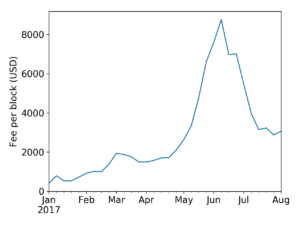The Bitcoin blockchain — currently 140GB and growing — contains a massive amount of data that can give us insights into the Bitcoin ecosystem, including how users, businesses, and miners operate. Today we’re announcing BlockSci, an open-source software tool that enables fast and expressive analysis of Bitcoin’s and many other blockchains, and an accompanying working paper that explains its design and applications. Our Jupyter notebook demonstrates some of BlockSci’s capabilities.
Current tools for blockchain analysis depend on general-purpose databases that have full support for transactions. But that’s unnecessary for blockchain analysis where the data structures are append-only. We take advantage of this observation in the design of our custom in-memory blockchain database as well as an analysis library.
BlockSci’s core infrastructure is written in C++ and optimized for speed. (For example, traversing every transaction input and output on the Bitcoin blockchain takes only 10.3 seconds on our r4.2xlarge EC2 machine.) To make analysis more convenient, we provide Python bindings and a Jupyter notebook interface. This interface is slower, but is ideal for exploratory analyses and allows users to quickly iterate when developing new queries.
The code below shows the convenience of traversing the blockchain using straightforward Python idioms, built-in currency conversion using historical exchange-rate data, and the use of pandas DataFrames for analysis and visualization..
fees = [sum(block.fees) for block in chain.range('2017')] times = [block.time for block in chain.range('2017')] converter = blocksci.CurrencyConverter() df = pandas.DataFrame({"Fee":fees}, index=times) df = converter.satoshi_to_currency_df(df, chain)
When plotted, it results in the following graph showing the average transaction fee per block:

BlockSci uses a custom data format; it comes with a parser that generates this data from the serialized blockchain format recorded by cryptocurrency nodes such as bitcoind. The parser supports incremental updates when new blocks are received, and making it easy to stay up to date with the latest version of the blockchain. We’ve used BlockSci to analyze Bitcoin, Bitcoin Cash, Litecoin, Namecoin, Dash, and ZCash; many other cryptocurrencies make no changes to the blockchain format, and so should be supported with no changes to BlockSci.
In our working paper, we present four analyses that show BlockSci’s usefulness for answering research questions. We show how multisignatures unfortunately weaken privacy and confidentiality; we apply the cluster intersection attack to Dash, a privacy-focused altcoin; we analyze inefficiencies in the usage of block space; and we present improved methods for estimating of how often coins change possession as opposed to just being shuffled around.
Here’s an illustrative example. Exploratory graph analysis using BlockSci allowed us to discover a behavioral pattern in the usage of multisignatures that weakens security. Multisignatures are a security-enhancing mechanism that distribute control of an address over a number of different public keys. Surprisingly, we found that users often negate this security by moving their funds from a multisig address to a regular address and then back again after a period of a few hours to days. We think this happens when users are changing the access control policy on their wallet, although it is unclear why they transfer their funds to a regular address in the interim, and not directly to the new multisig address. This pattern of behavior has led over $12 million dollars to be left insecure over the course of over 22,000 transactions. What users may not appreciate is that the temporary weakening of security is advertised to potential attackers on the blockchain.
There’s far more to explore on public blockchains. BlockSci is publicly available now, and we hope you’ll find it useful. It is easy to get started using the EC2 image we’ve released, which includes the Bitcoin blockchain data in addition to the tool. BlockSci is open-source, and we welcome contributions. This is an alpha release; we’re continuing to improve it and the interface may change a bit in future releases. We look forward to working with the community and to hearing about other creative uses of the data and the tool.
